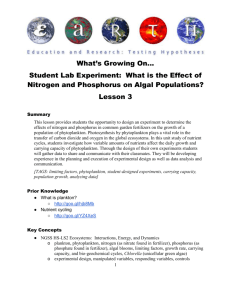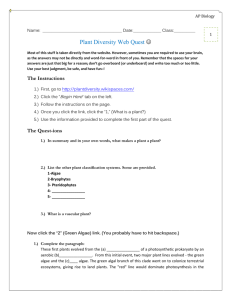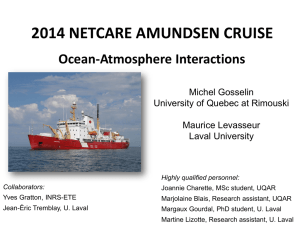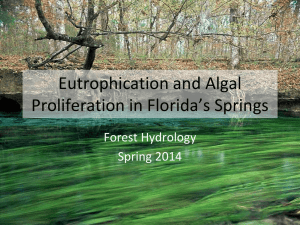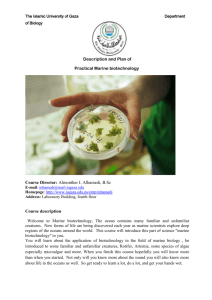Algal Biofuels: An Emerging Renewable Energy
advertisement
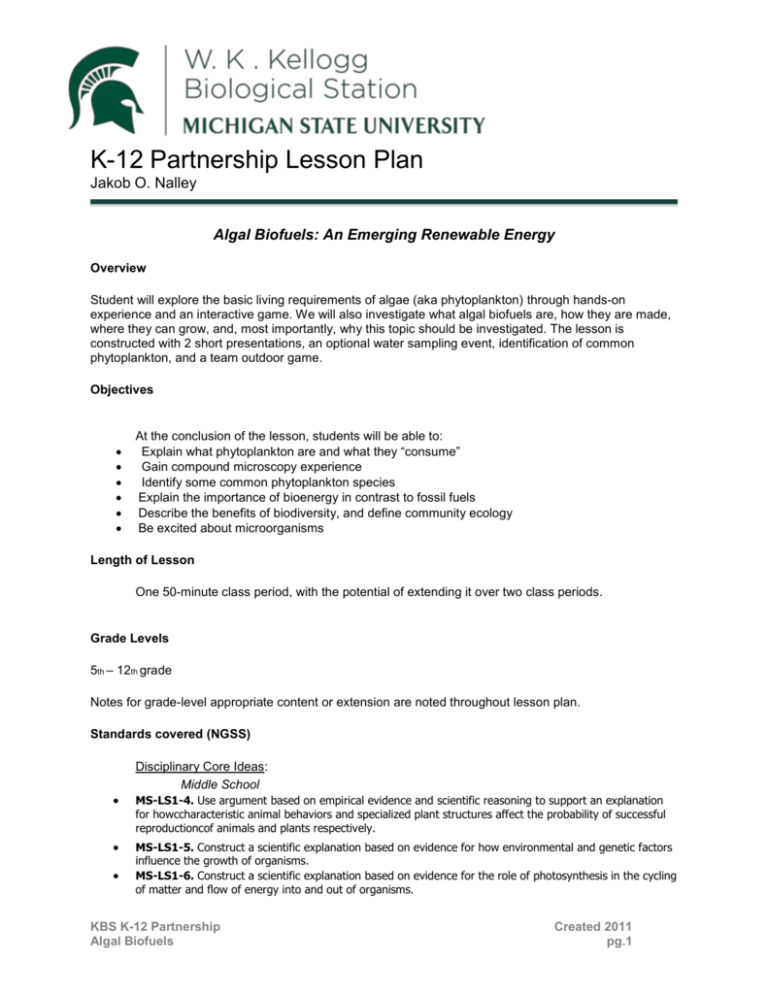
K-12 Partnership Lesson Plan Jakob O. Nalley Algal Biofuels: An Emerging Renewable Energy Overview Student will explore the basic living requirements of algae (aka phytoplankton) through hands-on experience and an interactive game. We will also investigate what algal biofuels are, how they are made, where they can grow, and, most importantly, why this topic should be investigated. The lesson is constructed with 2 short presentations, an optional water sampling event, identification of common phytoplankton, and a team outdoor game. Objectives At the conclusion of the lesson, students will be able to: Explain what phytoplankton are and what they “consume” Gain compound microscopy experience Identify some common phytoplankton species Explain the importance of bioenergy in contrast to fossil fuels Describe the benefits of biodiversity, and define community ecology Be excited about microorganisms Length of Lesson One 50-minute class period, with the potential of extending it over two class periods. Grade Levels 5th – 12th grade Notes for grade-level appropriate content or extension are noted throughout lesson plan. Standards covered (NGSS) Disciplinary Core Ideas: Middle School MS-LS1-4. Use argument based on empirical evidence and scientific reasoning to support an explanation for howccharacteristic animal behaviors and specialized plant structures affect the probability of successful reproductioncof animals and plants respectively. MS-LS1-5. Construct a scientific explanation based on evidence for how environmental and genetic factors influence the growth of organisms. MS-LS1-6. Construct a scientific explanation based on evidence for the role of photosynthesis in the cycling of matter and flow of energy into and out of organisms. KBS K-12 Partnership Algal Biofuels Created 2011 pg.1 MS-LS2-1. Analyze and interpret data to provide evidence for the effects of resource availability on organisms and populations of organisms in an ecosystem. MS-LS2-2. Construct an explanation that predicts patterns of interactions among organisms across multiple ecosystems. MS-LS2-5. Evaluate competing design solutions for maintaining biodiversity and ecosystem services. MS-ESS3-4. Construct an argument supported by evidence for how increases in human population and per-capita consumption of natural resources impact Earth’s systems. Cross Cutting Concepts: Cause and effect Energy and matter Patterns Stability and change Science and Engineering Practices Asking questions and defining problems Engaging in argument from evidence Constructing explanations and designing solutions. Materials PowerPoint of introduction to phytoplankton, their living requirements, and beautiful diversity (included “Phytoplankton Preview”). Projection Compound Microscope (x20-40) Photos of common algal species (included) Presentation on the overview of algal biofuel production (included - “Algal Biofuels”). 50 Large Flash Cards for the game 4 colors of construction paper, 50 squares in each color for the game Background Script to accompany “Phytoplankton Preview” PowerPoint, organized by slide: (1) Algae. When I say this, what do you think of? We are going to look at some of the living requirements that algae need to survive. The term alga includes thousands of species, each with unique diversity. Some of this diversity will be illustrated through photographs. (2) Animated Slide: Phytoplankton is derived from the Greek words “plant” + “wanderer.” The majority are immobile, reliant on the tides/water movement to transport them. They are aquatic, appearing in all water types from the ocean, estuaries, rivers, lakes, and puddles. The term photoautotrophic means that they create their own energy, derived from chemical reactions taking place in the chloroplasts stimulated from solar energy. Phytoplankton are quite small, unseen by the naked eye. In high densities, algae can be seen as “green water.” Massive blooms can be seen from space even (Picture from Baltic Sea)! (3) Animated Slide This is a generic pennate diatom. What are some living requirements that you think algae will need to survive? Answer: Nitrogen (in the form of nitrate), sunlight, carbon dioxide (from the atmosphere - benefit to society), water, phosphorus (phosphate), and silicon (for diatoms only). Do you think that the surrounding environment has any influence on the algal cells? Yes, of course it does. The water temperature influences the growth rates and the metabolism just like a rabbit in the winter/summer. The amount of sunlight also has a large influence on the alga growth. pH of the water can also influence day to day activities. Finally, predation and competition from others influence their growth and survival as well. (4) Microalgae are of great ecological importance. Phytoplankton are estimated to contribute over half of the O2 we breathe. Upwards to 80% is produced from aquatic systems with the addition of macrophytes KBS K-12 Partnership Algal Biofuels Created 2011 pg.2 (kelp, etc.). There is a definite threat to phytoplankton species as waters are warming from the greenhouse effect. It has been recently estimated in Nature that ocean waters have seen a decrease of 40% in phytoplankton density since 1950! Can you think how this would impact our oceans? Overall biosphere? (5) Diversity! Anabaena - a cyanobacteria (aka blue green algae). The larger cell is called a heterocyst that helps fix nitrogen for the colonial cells. Why is this important? It helps this invasive bacteria colonize and survive in conditions that other cells cannot. Palmodictyon contains a bunch of cells that are colonial contained within a sheath that is created and branches like a tree. Dinobryon is a golden algae (based on the coloration) and looks like it is in a champagne flute. Blooms of Dinobryon are noxious, smelling “fishey.” Eudorina is a 32-cell ball that is mobile from the individual flagella that point out of the ball. Can you think of a reason cells would evolve to colonize? Size helps limit predation. (6) More diversity! Scenedesmus is a green alga, living in 4 cell colonies with spines. Why would spines be created? For buoyancy issues, need to stay high in the water column. Cyclotella is a common diatom that looks like a tire. Pediastrum is a conglomerate of green algae cells. Coccolithophores are algal cells that use calcium carbonate to form “shields” that shroud the cell. Why are these necessary?? Script to accompany Prezi presentation for “Algal Biofuels” -Go to prezi.com and log-in with: Username: nalleyja@msu.edu Password: GK12algae -Click on Algal Biofuel Presentation, then select “View Together” and finally select “Start Presenting” 1.) This is an overview cartoon of the entire biofuel production process. Does this system look any different to what you would expect to see with fossil fuel generation? Yes, it is a somewhat closed loop (aka renewable), whereas fossil fuels are non-renewable. 2.) This is a zoom in on the first portion of the entire system. The production of the feedstock from algae is certainly an emerging technology. Inputs include CO 2, H2O, nitrogen, phosphorous, silicon (diatoms), solar energy. Economics have shown that open ponds for cultivation are the most economically feasible option for algae production. But these systems will have changing temperatures, sunlight, pH, and other external factors to deal with. Unwanted algal species can be introduced too from ducks landing in them or from the wind as well. But an emerging answer to these concerns involves ecological options, which will be covered in a few slides. 3.) This is a photo of active research taking place in Arizona. The towers are the Closed Photobioreactors that are extremely expensive, so other options, such as the open ponds to the right are being explored. These ponds are much more inexpensive, but as mentioned earlier have some problems associated with them (aka Duck Butt Introduction) 4.) Main overview again. 5.) The end goal for this process is obtaining high amounts of neutral lipids, or fats of the cell. These can be converted into diesel fuel, and even jet fuel. 6.) Here is a great photo of algal cells that are stained with a dye to show the fats within the cells. All of the green color you see are fat pockets, and the red glow is from the chloroplast within the cells. 7.) Main overview again. 8.) Some current work being done at Michigan State University is looking at cultivating multiple species of algae within the same pond to utilize some of the benefits associated with biodiversity. This slide shows that as the number of species increases, the RUE or resource use efficiency of the overall habitat increases. Meaning that the different species use up more of the resources that are available making the system more efficient. The big graph at the bottom shows an experiment where Nalley changed the light KBS K-12 Partnership Algal Biofuels Created 2011 pg.3 intensity the algae experienced. Single species grew well at one condition but grew poorly at the other light level. But when these species were living together, the “Mixture” line, we see that the overall number of individuals continued to increase. Researchers believe that with higher biodiversity in the ponds, they will achieve higher and more consistent algal growth than at lower biodiversity. 9.) Can these little green warriors save the planet? There is great potential. The map of the US shows where giant ponds can be built to maximize growth. As we can tell, it is all in the southwest of the US. Can anyone think of a problem these open ponds will have in the heat? Evaporation! Currently the price of gas from algae is set up to $40 a gallon, but by recycling the nutrients and getting better yields that can fall to $2.50/gallon. Algae can generate more gallons of gasoline than any other alternative fuel source; look at the comparison betweenalgae and soybeans! 10.) Questions? My email is nalleyja@msu.edu if you have any questions, please feel free to email me. 11.) Game time. There will be four teams, each with their own living requirements. Each student will receive a card with the team name and the living requirements written on the card. a. Team Green: Fast in Hot Conditions, need CO2 Sunlight and Nitrogen b. Team Gold: Fast in Cold Conditions, need CO2 Sunlight and Nitrogen c. Team Diatom: Fast in All Conditions, need CO2 Sunlight and Nitrogen and Silicon d. Team Cyano: Slow in All Conditions, need CO2 and Sunlight Teachers will need to prepare cards in advance, and also cards to be scattered throughout the habitat (predetermined area of play), that will be either Sunlight, Nitrogen, CO 2, or Silicon (for diatoms). Some options for scenarios could be: o Hot weather - Diatoms and Greens do well o Cold Weather - Diatoms and Golds do well o No Nitrogen - Cyanos will quickly o No Silicon - Diatoms die quickly Activities of the session 1. Present the introduction in the PowerPoint (included) asking comprehension questions throughout. This should make the lesson connect to students’ previous knowledge. 2. Set up scopes of algae for students to identify and get to know. Provide a “key” that has photos of some of the algal species they will see. Any water source will have algal samples, you will just need a bottle to collect them in. Vortex the bottle (if available) to make settle the algae to the bottom. 3. Introduction to Algal Biofuels, prezi.com. User: nalleyja@msu.edu Password: GK12algae 4. Game: Slide at the end of Prezi to explain the game more thoroughly Resources PowerPoint created by Jakob Nalley Prezi Presentation: by Jakob Nalley Game Development: Jakob Nalley Extensions and Modifications Read articles from multiple sources (e.g., news, primary literature), and (a) have a discussion of current scientific and social standings on bioenergy, (b) have students write a recommendation for future scientific testing, (c) write an opinion piece on what society should do about bioenergy, and/or (d) structure a debate about an issue related to bioenergy. KBS K-12 Partnership Algal Biofuels Created 2011 pg.4 Have students design an experiment to test topics related to bioenergy. Have students draw out the cycles (with as much simplicity or complexity as you would like) for CO2 in the fossil fuels process and the biofuel/grassoline process. For elementary students, you could have precut pictures of the different parts of the processes, and students could draw connections between them. Every point of this presentation can be scaled back to meet demands at specific grade levels. Other aspects can be developed even further to meet higher demands at the high school level. Assessment Have students draw processes of CO2 through (a) fossil fuel use and (b) bioenergy use (Answer: pictures in PowerPoint slides). For lower grades, you can provide picture cutouts of the parts of the processes (fossil fuels or grass, gasoline pump, car, arrows, and CO 2). Have students explain which process increases CO2 release into the environment (Answer: fossil fuels) and which might reduce CO2 emissions (Answer: bioenergy). What are some of the benefits to society for us to switch to bioenergy, in particular algal biofuel? (Answer: less CO 2, remediate climatic changes, domestically produced fuel, consistent yields, steady prices, etc.) Have students explain why bioenergy is important for minimizing future climate change. (Answer: Carbon dioxide is a greenhouse gas that traps light energy from the sun, which contributes to climate change [For lower grades: Carbon dioxide causes climate change]. Using bioenergy as fuel reduces CO2 release into the atmosphere. Thus, this process doesn’t contribute to increased climate change.) KBS K-12 Partnership Algal Biofuels Created 2011 pg.5


